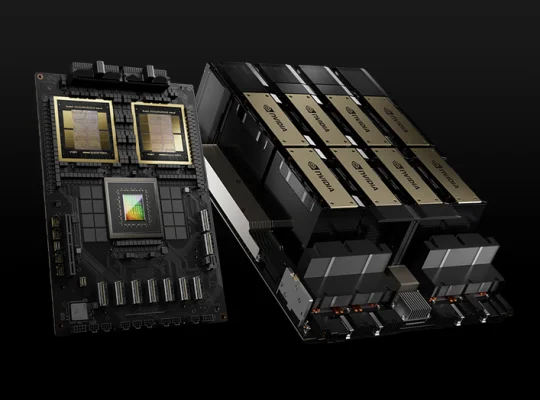The world of AI and GPUs is constantly in motion, and Nvidia is at the center of it, with a stream of announcements and developments coming from its key events and partnerships. Here’s a summary of recent breaking news regarding Nvidia’s AI and GPU advancements:
Blackwell and the Next Generation of AI Chips
- Blackwell Dominance: Nvidia’s Blackwell architecture is not just a success; it’s being hailed as the fastest product ramp-up in the company’s history. According to recent reports, Blackwell GPUs are now responsible for nearly 70% of Nvidia’s data center compute revenues, with major cloud providers rapidly deploying tens of thousands of these GPUs weekly to build “AI factories.”
- Next-Gen Chips on the Horizon: Following the Blackwell B200, Nvidia has already detailed its future roadmap. The next-gen GB300 chip, an upgrade to the GB200, is set to be shipped during the calendar third quarter of 2025. It promises a 50% performance boost over the GB200. Looking further ahead, the Vera Rubin chip family is slated for a 2026 release, which will consist of a custom Nvidia CPU (Vera) and a new GPU (Rubin). A “Rubin Ultra” chip is also planned for 2027.
- New GeForce RTX 50 Series: For the consumer market, Nvidia has released its GeForce RTX 5090 and 5080 GPUs, built on the Blackwell architecture. These new cards feature enhanced AI capabilities, including a 77% increase in memory bandwidth for the RTX 5090 compared to its predecessor. They are designed to accelerate content creation, gaming, and various AI-powered applications, with new features in the Nvidia Broadcast application to improve video and audio quality.
New Software and Ecosystem Developments
- Blackwell Ultra and Agentic AI: Nvidia has introduced Blackwell Ultra, a new iteration of its Blackwell chips designed specifically to handle the demands of “agentic AI” and “physical AI,” which involve reasoning and real-world interactions. The company claims these chips could provide a significant revenue increase over the previous Hopper generation.
- Robotics and Physical AI: A major focus for Nvidia is the development of humanoid robots. The company has introduced Isaac GR00T N1, an open-source foundational model for humanoid robotics, along with new simulation frameworks. This is part of a broader vision for “physical AI,” where AI systems can understand and interact with the physical world. This initiative is being advanced through partnerships with companies like Google DeepMind and Disney.
- New AI Infrastructure: Nvidia is moving beyond just chips to provide a full-stack solution for AI development. They have announced products like DGX Spark and DGX Station, which are personal AI supercomputers designed to run large models from a desktop. They also launched Omniverse Cloud to integrate advanced simulation and AI into complex 3D workflows.
- Partnerships: Nvidia continues to expand its influence through strategic partnerships. Key collaborations have been announced with General Motors to build self-driving car fleets and with telecoms to advance 6G networks. The company also joined a new AI Infrastructure Partnership with BlackRock, Microsoft, and Elon Musk’s xAI, which aims to improve AI capabilities and build energy-efficient data centers.
Geopolitical and Market News
- China Market: In a significant development, Nvidia has reportedly ordered 300,000 of its H20 chips (a less-powerful chip designed to comply with U.S. export restrictions) from TSMC. This comes as sales are expected to resume in China following discussions with the U.S. government, indicating strong continued demand for Nvidia’s products in the Chinese market.
- Financial Performance: Nvidia’s strong performance is reflected in its latest quarterly results, with data center revenues showing a massive year-over-year increase, largely fueled by the demand for its Blackwell GPUs. The company’s stock has also seen a significant rise, outperforming the broader tech sector.















